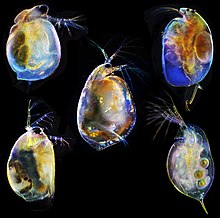The Cladocera, commonly known as water fleas are an order of small crustaceans that feed on microscopic chunks of organic matter (excluding some predatory forms). [1]
Over 650 species have been recognised so far, with many more undescribed.[2][3][4][5] The oldest fossils of cladocerans date to the Jurassic, though their modern morphology suggests that they originated substantially earlier, during the Paleozoic. Some have also adapted to a life in the ocean, the only members of Branchiopoda to do so, even if several anostracans live in hypersaline lakes.[6] Most are 0.2–6.0 mm (0.01–0.24 in) long, with a down-turned head with a single median compound eye, and a carapace covering the apparently unsegmented thorax and abdomen. Most species show cyclical parthenogenesis, where asexual reproduction is occasionally supplemented by sexual reproduction, which produces resting eggs that allow the species to survive harsh conditions and disperse to distant habitats.
| Cladocera | |
|---|---|
 | |
| Scientific classification | |
| Kingdom: | |
| Phylum: | |
| Subphylum: | |
| Class: | |
| Subclass: | |
| Superorder: | Cladocera Latreille, 1829 |
| Suborders | |
| |
| Synonyms | |
Eucladocera (no evidence for grouping together all other cladocerans as the sister taxon to the monotypic Haplopoda (Leptodora)) | |
https://en.wikipedia.org/wiki/Cladocera
above.
No comments:
Post a Comment